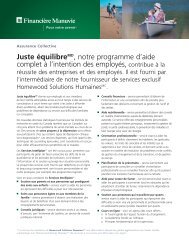Laser eye surgery notes - Manulife
Laser eye surgery notes - Manulife
Laser eye surgery notes - Manulife
- No tags were found...
You also want an ePaper? Increase the reach of your titles
YUMPU automatically turns print PDFs into web optimized ePapers that Google loves.
<strong>Laser</strong> Eye Surgery<br />
<strong>Laser</strong> <strong>surgery</strong> alters the outer layer of<br />
the <strong>eye</strong>, specifically the cornea. The<br />
outer <strong>eye</strong> is composed of three parts: the<br />
cornea, the clear part that covers the<br />
pupil and iris; the sclera, the white part<br />
of the <strong>eye</strong>; and the limbus, the outer<br />
area of the cornea where it attaches to<br />
the sclera.<br />
Light is refracted in two stages, first by<br />
the cornea, second by the lens. The light should focus clearly on the retina (the optic nerve<br />
receptor) for good vision.<br />
Four kinds of refractive error can cause vision problems.<br />
o Myopia, or near-sightedness occurs when the <strong>eye</strong> is elongated (oval shaped) from front to<br />
back. This causes light rays to focus in front of the retina. So while the <strong>eye</strong> can focus on<br />
close objects, distant objects are blurry.<br />
o Hyperopia, or far-sightedness happens when the <strong>eye</strong> is oval shaped from top to bottom.<br />
This causes light rays to focus behind the retina. As a result the <strong>eye</strong> can focus on distant<br />
objects, but close objects are blurry.<br />
o Astigmatism means the cornea itself is misshaped and is oval like a football rather than<br />
spherical like a basketball. It causes more than one focal point within the <strong>eye</strong>, distorting<br />
vision both close-up and at a distance.<br />
o Presbyopia occurs with aging as the <strong>eye</strong>’s ability to focus diminishes because the lens<br />
becomes less elastic. Close objects are focused behind the retina; this explains why people<br />
need bifocals or reading glasses when they get older. This condition affects almost everyone<br />
after the age of 50 – presbyopia cannot be corrected by laser <strong>surgery</strong>.<br />
Is <strong>Laser</strong> Eye Surgery the Solution<br />
Lots of press has been given to laser <strong>eye</strong> <strong>surgery</strong> in recent years. And no wonder! People who<br />
wear glasses or contacts know how liberating it would be to live without them. Anyone who<br />
wears glasses understands the frustration of fumbling for glasses just to see a bedside alarm<br />
clock.<br />
But before running to the closest laser clinic, people must know the risks and the benefits of laser<br />
<strong>eye</strong> <strong>surgery</strong>. They must remember laser <strong>eye</strong> <strong>surgery</strong> is not reversible.<br />
Someone considering laser <strong>eye</strong> <strong>surgery</strong> should consult with a physician, and be as frank as<br />
possible about medical history and what he or she hopes to gain from having <strong>surgery</strong>. A doctor<br />
needs complete information to give good advice about suitable medical procedures.<br />
1
Types of procedures<br />
The excimer laser, the basic laser used for <strong>eye</strong> <strong>surgery</strong>, emits high-energy ultraviolet light. The<br />
laser is precise, causing minimal damage to surrounding tissue. Two methods of corrective laser<br />
<strong>eye</strong> <strong>surgery</strong> have garnered the most attention: LASIK and PRK.<br />
LASIK (laser in-situ keratomileusis) is used to treat near-sightedness, far-sightedness, and<br />
astigmatism. LASIK is the latest procedure to find wide use in laser <strong>eye</strong> <strong>surgery</strong>, as it seems to<br />
be more effective and has fewer complications than PRK. In this procedure a surgeon cuts a flap<br />
in the stroma (the cornea’s middle layer) and then uses a laser to remove some of the tissue under<br />
the flap, reshaping the cornea. The flap is replaced and the cornea is allowed to heal naturally.<br />
The whole procedure takes less than a few minutes per <strong>eye</strong>.<br />
PRK (photorefractive keratectomy) can also be used to treat near-sightedness, far-sightedness,<br />
and astigmatism. In this procedure a surgeon uses a laser to reshape the cornea by removing<br />
tissue from the surface of the cornea. As with LASIK, this procedure takes only a few minutes<br />
per <strong>eye</strong>.<br />
Radial keratotomy (RK), is used less and less often, and corrects mild to moderate<br />
nearsightedness. In this procedure the surgeon makes incisions in a radial (spoke-like) pattern in<br />
a patient’s cornea, causing it to flatten, thus reducing nearsightedness. This procedure typically<br />
takes less than half an hour.<br />
Other emerging treatments<br />
New methods are currently under review. LASEK (laser epithelial keratomileusis), for instance,<br />
is similar to LASIK; however, a surgeon cuts the flap in the epithelium (the cornea's outer layer)<br />
instead of the stroma (the cornea’s middle layer). Since the flap is closer to the outer layer of the<br />
cornea, if an infection occurs it would be easier to treat.<br />
Corneal rings are emerging as another treatment for mild near-sightedness and mild astigmatism.<br />
In this procedure, the surgeon inserts a ring inside the cornea, causing it to flatten, and altering<br />
the way light refracts through the cornea. The procedure typically takes 15 minutes and, unlike<br />
laser methods, is reversible.<br />
An implantable contact lens is an experimental device that fits behind the cornea. A surgeon<br />
places an artificial lens (something like a contact lens) behind the cornea, but in front of the <strong>eye</strong>’s<br />
natural lens. This procedure typically takes 20 minutes and is completely reversible. Since this<br />
procedure uses a lens, it can correct near-sightedness, far-sightedness, and astigmatism.<br />
The benefits realized by patients usually involve lifestyle changes, but they can be significant,<br />
and can be summed up in one word: freedom.<br />
Free to swim, play basketball, or dance, without contacts or special glasses. Free to look through<br />
binoculars or a camera without first having to take off glasses. Free from paying for new glasses<br />
every couple of years.<br />
2
However, some people might require glasses again, even after <strong>surgery</strong>. As people age, visual<br />
acuity often continues to deteriorate regardless of corrective <strong>surgery</strong>. Surgery corrects vision; it<br />
does not cure the underlying cause of visual deterioration.<br />
Recovery is very patient specific. Some patients may be able to see clearly within 24 hours,<br />
while others may take several weeks to achieve visual acuity. Although a patient may be able to<br />
see clearly in the early stages of recovery, it is important to avoid any great jarring for many<br />
months. Physical sports like football, or other strains such as airbags, can cause post-surgical<br />
complications.<br />
A patient should also commit to the follow-up regimen prescribed by the physician. Shortcuts<br />
should not be taken when it comes to vision.<br />
The risks can range from minor to major. Minor risks may include sensitivity to light, as well as<br />
under or over-correction.<br />
Major risks include permanent damage to the cornea due to error or infection. Health Canada<br />
<strong>notes</strong>: “Fortunately, complications are rare. However, it is important to realize that the changes<br />
made to your <strong>eye</strong>s during laser <strong>surgery</strong> are not reversible, and complications or risks increase<br />
significantly if you are not a suitable candidate for laser <strong>surgery</strong>.” (http://www.hc-sc.gc.ca/hpbdgps/therapeut/zfiles/english/publicat/iyh_laser<strong>eye</strong>_e.html).<br />
Those considering <strong>eye</strong> <strong>surgery</strong> should choose their surgeon and procedure carefully.<br />
Not everyone is an ideal candidate for laser <strong>eye</strong> <strong>surgery</strong>. The following points will help those<br />
considering a procedure determine whether they are ideal candidates:<br />
– It is important that a person’s <strong>eye</strong>sight has been stable – the prescription has not changed<br />
– for more than two years.<br />
– Some medical conditions, including auto-immune diseases such as lupus or HIV, can<br />
interfere with the process of healing. Diabetes can also inhibit healing.<br />
– Drugs, such as steroids and certain acne prescriptions, can also inhibit healing.<br />
– People who are pregnant or use an oral contraceptive may not be good candidates.<br />
– A personal and/or family history of <strong>eye</strong> diseases can affect the outcome of laser <strong>eye</strong><br />
<strong>surgery</strong>. Conditions such as herpes simplex, shingles in the <strong>eye</strong> area, glaucoma or dry<br />
<strong>eye</strong>s, should be brought to the attention of an <strong>eye</strong> care professional.<br />
– People with large pupils under low light conditions – as determined by an<br />
ophthalmologist – may experience symptoms such as glare, halos, starbursts or ghost<br />
images after laser <strong>surgery</strong>. This may interfere with a person’s ability to drive at night<br />
– In some cases, LASIK <strong>surgery</strong> can weaken the structure of the <strong>eye</strong>ball. This can increase<br />
the risk to a patient’s <strong>eye</strong>s if that person takes part in activities such as football, wrestling<br />
or boxing.<br />
– Even when the <strong>surgery</strong> goes well, there is no guarantee that a patient won't need glasses<br />
or contacts again at some point. As people grow older, their <strong>eye</strong>s continue to change.<br />
– Stephen F. Brint, M.D., Dennis Kennedy, O.D., and Corinne Kuypers-Denlinger point<br />
out in their book The <strong>Laser</strong> Vision Breakthrough: “Second procedures are necessary for<br />
3
10 to 20 percent of patients and are more common in patients with higher degrees of<br />
refractive errors.” (Page 159).<br />
– Some people notice a change in their night vision after laser <strong>surgery</strong>, and people over 40<br />
will probably still need glasses for reading fine print. Prospective patients should discuss<br />
their expectations with their <strong>eye</strong> care professional so that they won't be disappointed.<br />
Source: Health Canada: © Minister of Public Works and Government Services Canada, (2001).<br />
Other Considerations<br />
– Some jobs have specific vision requirements, and laser <strong>eye</strong> <strong>surgery</strong> might affect a<br />
person’s prospects for employment in some fields. It is wise to investigate this before<br />
<strong>surgery</strong>.<br />
– Medical advances are bound to continue. New reversible surgical procedures are already<br />
being investigated. It may be worth waiting until even more reliable surgeries are<br />
available. For instance, corneal rings, which are placed inside the edge of cornea causing<br />
it to take a new shape and correcting for near-sightedness, are currently being studied for<br />
approval. Likewise corrective lenses can be placed behind the cornea to correct any<br />
vision problems.<br />
Source: Health Canada: © Minister of Public Works and Government Services Canada, (2001).<br />
Benefits Coverage<br />
Some benefits carriers allow plan members to apply vision care coverage toward the cost of laser<br />
<strong>eye</strong> <strong>surgery</strong>. The maximum is specified by a member’s plan, with typical coverage between<br />
$100 and $300 every two years.<br />
As of November 1, 2001, <strong>Manulife</strong> will begin covering laser <strong>eye</strong> <strong>surgery</strong> under the vision benefit<br />
subject to the prescription glasses maximum (see the Q2 and Q3 Administrative Updates for<br />
more information).<br />
Both employers and employees should know long-term evidence is not available to show laser<br />
<strong>eye</strong> <strong>surgery</strong> reduces the lifetime costs of vision care. Unless long-term cost benefits can be<br />
demonstrated, it is unlikely that benefits carriers will pay more than the typical vision care<br />
coverage for laser <strong>eye</strong> <strong>surgery</strong>.<br />
In some circumstances it may be cost effective for an employer to pay for corrective <strong>eye</strong> <strong>surgery</strong>,<br />
such as factories where workers wear prescription safety glasses that need regular replacement.<br />
The last word<br />
<strong>Laser</strong> <strong>eye</strong> <strong>surgery</strong> has helped thousands of Canadians to see clearly without glasses or contact<br />
lenses. In most cases, laser <strong>eye</strong> <strong>surgery</strong> is successful, but potential patients should remember, it<br />
is still <strong>surgery</strong> and carries inherent risk. Anyone considering a laser <strong>eye</strong> procedure should<br />
thoroughly discuss risks and benefits with their <strong>eye</strong> care professional before they decide to have<br />
the <strong>surgery</strong>.<br />
4
















